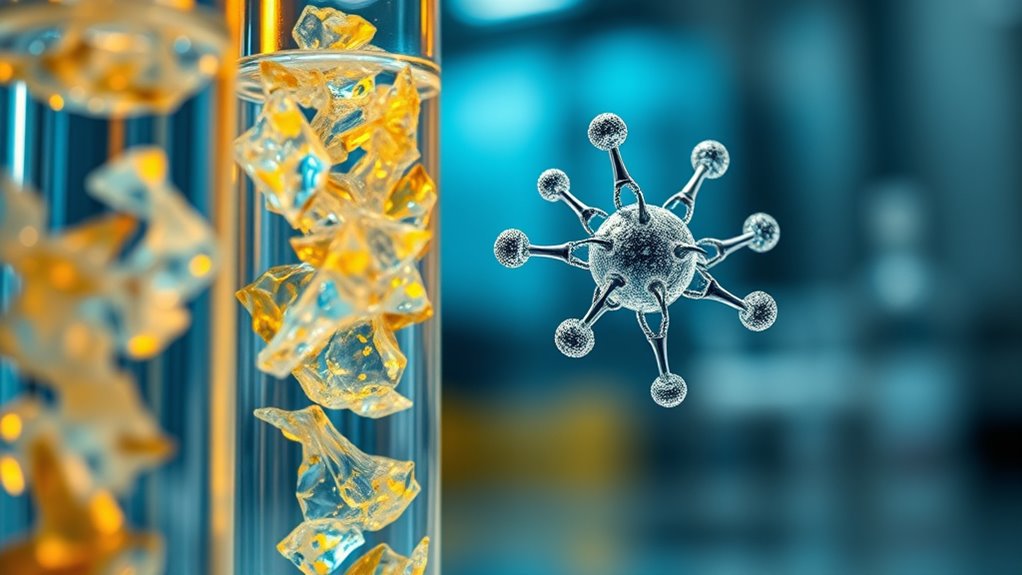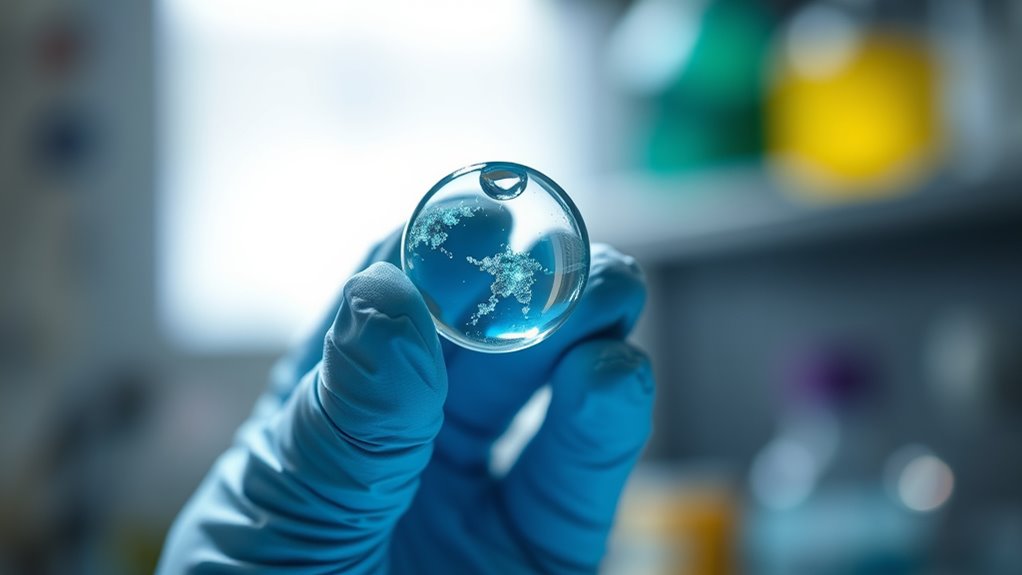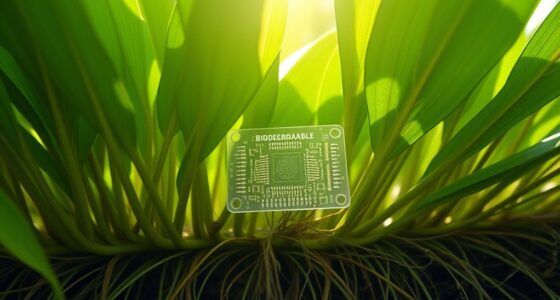Plastic-degrading enzymes like PETase represent a breakthrough in recycling because they can break down PET plastics into reusable building blocks, helping reduce waste and pollution. These enzymes work efficiently at breaking the ester bonds in plastics, turning polyesters into materials that can be remade into new products. Advances in enzyme engineering are making these processes more effective and sustainable. If you want to discover how these enzymes are transforming waste management, keep exploring the fascinating science behind them.
Key Takeaways
- PETase enzymes can specifically degrade PET plastics into reusable monomers, enabling sustainable recycling.
- Structural engineering improves enzyme stability and efficiency, making enzymatic recycling more practical.
- Enzymatic recycling reduces microplastic formation and environmental pollution compared to conventional methods.
- PETase evolved from plant-wax degrading enzymes, adapting recently to target synthetic plastics like PET.
- Advancements in enzyme discovery and modification are driving innovative solutions for plastic waste management.

You should know that enzymes like lipases, esterases, and cutinases have been known to degrade polyester plastics since the 1970s. However, PETase is unique because it specifically targets PET and similar plastics like PEF, a bioderived PET alternative. Unfortunately, PETase doesn’t work on aliphatic polyesters like polylactic acid or polybutylene succinate, nor does it degrade polyethylene (PE) or polyvinyl chloride (PVC) effectively. The enzymes operate by cleaving ester bonds through hydrolysis, using a tunnel-shaped active site that accommodates long polymer chains. A catalytic triad within PETase plays an essential role in its hydrolytic activity, and ongoing structural biology research aims to improve these enzymes’ efficiency, stability, and ability to withstand higher temperatures. Research continues to explore enzyme variants with enhanced thermostability and activity. This ongoing research is critical for developing more efficient enzymatic recycling methods that could transform waste management practices. You’ll find that the origin of PETase is linked to enzymes that originally degraded plant waxes, which evolved to adapt specifically for PET breakdown in recent years. This discovery sparked a wave of research focused on understanding enzyme structure and how to engineer them for better performance. PETase and MHETase work together efficiently, converting PET into reusable monomers, which can then be repolymerized into new plastics — creating a closed-loop recycling system. This method not only reduces plastic waste but also cuts down on microplastic contamination and lowers the environmental footprint compared to traditional chemical or mechanical recycling.
Ultimately, these enzymes offer a faster, greener alternative to degrade plastics naturally. They markedly cut down the time needed for degradation, helping to address the global plastic pollution crisis. Advances in enzyme engineering promise even more effective solutions, making enzymatic recycling a promising step toward sustainable waste management. By harnessing these biological tools, you can help turn plastic waste into valuable resources, contributing to a cleaner and healthier planet.
Frequently Asked Questions
Are Plastic-Devouring Enzymes Commercially Available Now?
Right now, plastic-devouring enzymes aren’t widely available commercially. You might find some pilot projects or research initiatives, but full-scale industrial plants are still in development. Companies are working on engineering more efficient enzymes, and experts expect commercial recycling plants using these enzymes to start emerging late this decade. So, while the technology is promising, you won’t see it fully operational in everyday recycling facilities just yet.
What Types of Plastics Can These Enzymes Degrade?
Imagine a world where plastics vanish in hours, not centuries. You’d see PET bottles broken down into monomers, polyester waste turning into reusable building blocks, and even stubborn polyethylene chains oxidized by specialized enzymes. These enzymes target a variety of plastics, from PET and other polyesters to some hydrocarbons like polyethylene. While still evolving, they promise a future where mixed plastics and microplastics are more manageable through enzyme-assisted recycling.
How Long Does the Biodegradation Process Typically Take?
You want to know how long biodegradation takes. Generally, enzymatic processes can break down plastics much faster than natural methods. For example, PET bottles can be degraded by engineered enzymes in about 10 hours, while polystyrene can be depolymerized in just 24 hours with larvae and microbes. Industrial enzyme use can even speed up the process to just a few days, making recycling more efficient and environmentally friendly.
Are There Any Environmental Risks Associated With These Enzymes?
You might wonder about the environmental risks of these enzymes. They could interact with non-target plastics, altering ecosystems if released uncontrolled. Breakdown products may be toxic to wildlife, and enzymes might persist longer than expected, disrupting natural processes. There’s also a risk of genetic material transferring to native microbes, which could change microbial communities. Proper containment and regulation are essential to minimize these potential ecological impacts.
Can These Enzymes Be Integrated Into Existing Recycling Facilities?
You’re asking if these enzymes can be integrated into existing recycling facilities, and it’s not a walk in the park. You’ll need to retrofit or redesign current machinery, optimize conditions, and manage costs. While promising, scaling enzyme use involves technical hurdles, like handling crystalline PET and maintaining enzyme stability. With innovation and investment, you could turn these challenges into opportunities, ultimately making recycling faster, greener, and more efficient.
Conclusion
So, here you are, marveling at enzymes that can eat plastic—yet, they might be our last hope for a cleaner planet. It’s almost ironic, isn’t it? We’ve spent decades creating plastic that’s nearly indestructible, and now, nature’s own enzymes are the unexpected heroes. Maybe, just maybe, those tiny, humble enzymes will save us from ourselves, proving that sometimes, the ultimate solution is a simple, biological twist of fate.










